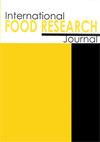以甲基纤维素为发泡剂的泡沫板干鲷鱼粉:理化及功能特性
IF 0.7
4区 农林科学
Q4 FOOD SCIENCE & TECHNOLOGY
引用次数: 0
摘要
以甲基纤维素(MC)为发泡剂,分别以0.0、0.5、1.0和1.5% w/w的浓度,在70和80℃条件下进行泡沫干燥。目的是确定干燥温度和发泡剂加入量对粉末样品的物理化学和功能特性的影响。鱼粉的水活度(law)为<0.40,显著增加(p <0.05),随MC浓度和干燥温度的升高。蛋白质溶解度(PS)和持水量(WHC)与干燥温度呈负相关(r分别为-0.943和-0.749)。与温度(r = 0.462)相比,乳化性能与MC (r = -0.839)呈较强的负相关。70℃干燥鱼粉的TBARS和FFA值显著低于80℃(p <0.05)。两种鱼粉的脂肪和灰分含量无显著差异,但粗蛋白质含量在70°C干燥的鱼粉中显著高于粗蛋白质。在70°C下干燥导致粉末的整体性能优越,0.5% MC是最好的处理。本文章由计算机程序翻译,如有差异,请以英文原文为准。
Foam-mat dried Japanese threadfin bream (Nemipterus japonicus) powder with methyl cellulose as the foaming agent: Physicochemical and functional properties
Minced meat of Japanese threadfin bream (Nemipterus japonicus) was foam-mat dried at 70 and 80°C using methyl cellulose (MC) as the foaming agent at concentrations of 0.0, 0.5, 1.0, and 1.5% w/w. The objective was to determine the effect of drying temperature and amount of foaming agent incorporated on the physicochemical and functional properties of the powdered samples. Fish powders had a water activity (aw) of < 0.40, which significantly increased (p < 0.05) with increasing MC concentrations and drying temperatures. Protein solubility (PS) and water holding capacity (WHC) were inversely correlated with the drying temperature (r = -0.943 and -0.749, respectively). Emulsification property had a strong inverse correlation with MC (r = -0.839) as compared to temperature (r = 0.462). The TBARS and FFA values of the fish powders dried at 70°C were significantly lower than at 80°C (p < 0.05). No significant differences were obtained in their fat and ash contents, except for crude protein, which was significantly higher in the fish powder dried at 70°C. Drying at 70°C resulted in overall superior powder properties, with 0.5% MC being the best treatment.
求助全文
通过发布文献求助,成功后即可免费获取论文全文。
去求助
来源期刊

international food research journal
Agricultural and Biological Sciences-Food Science
CiteScore
1.40
自引率
0.00%
发文量
75
期刊介绍:
The International Food Research Journal (IFRJ) publishes papers in English, six (6) issues a year with the coverage of:
Food Science and Technology
Nutrition and Dietetics
Agriculture, multidisciplinary
Chemistry, multidisciplinary
The scope of the Journal includes:
Food Science, Food Technology and Food Biotechnology
Product Development and Sensory Evaluation
Food Habits, Nutrition, and Health
Food Safety and Quality
Food Chemistry, Food Microbiology, Food Analysis and Testing
Food Engineering
Food Packaging
Food Waste Management
Food Entrepreneur
Food Regulatory
Post-Harvest Food Management
Food Supply Chain Management
Halal Food and Management
 求助内容:
求助内容: 应助结果提醒方式:
应助结果提醒方式:


